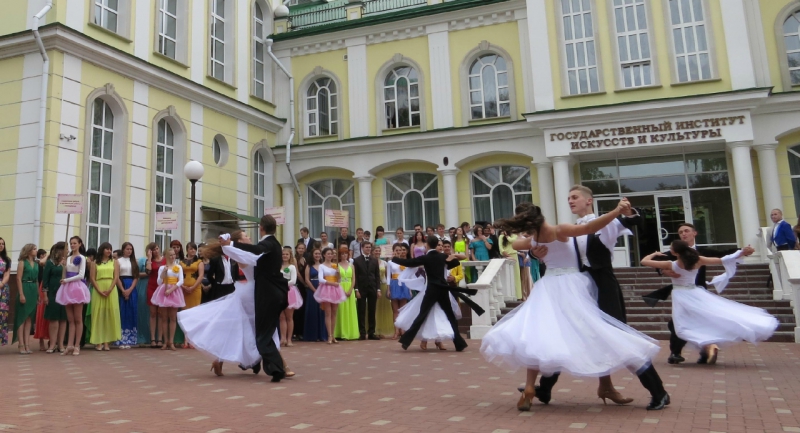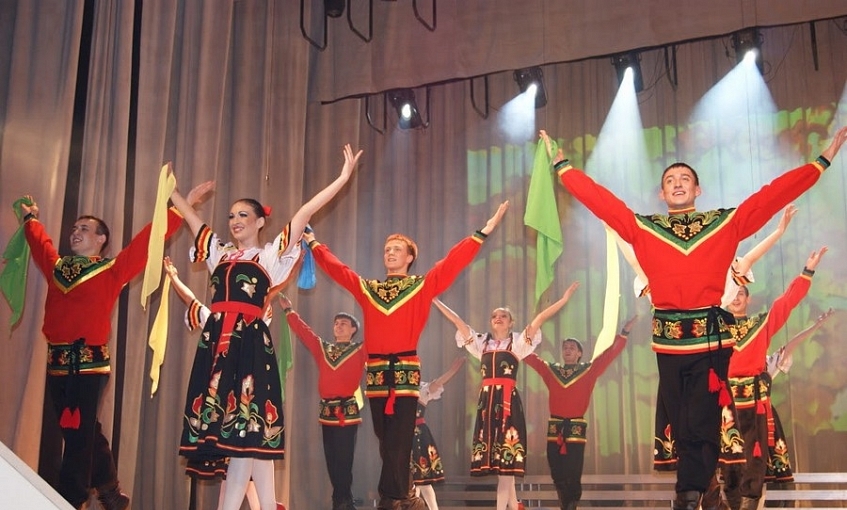People who have connected their lives with creativity on a professional level are often self-taught - that is, they do not receive the proper education of an actor, dancer or vocalist, director or stage designer. Nevertheless, most still prefer to unlearn and get crusts confirming their qualifications. In Orel, this can be done at the Oryol State Institute of Culture. More details about this university will be discussed later.
OGIK, Oryol: start
The Institute’s official birthday is March 15, 1972. However, the decision to open such an educational institution in this city was made much earlier - for as much as six months, in August 1971. It was then that the Ministry of Culture of our country decided that the city of Oryol really needs a branch of the Moscow Institute of Culture. No sooner said than done, and a branch in the glorious city opened.
Thus, to consider the Oryol State Institute of Culture (or OGIK for short) an independent university from the moment of its “birth” is also unlawful. He became an independent unit much later - however, we will not get ahead of ourselves. We will return to this issue in due time.
Administrative issues
As already mentioned, March 15, 1972 is the opening date of the university, the day of signing all the necessary papers. However, students, of course, were not at the institute at that time yet - what kind of recruitment could be discussed at the very height of the school year! The management of the new branch has so far decided all sorts of administrative issues: it opened departments, prepared premises, and recruited staff.
Speaking of premises. Of course, no one was going to provide a new building for the university - there was simply nowhere to take it. The Moscow Cultural Branch was placed in a building that had previously belonged to one of the city’s boarding schools. There, of course, repairs were required, but in the first year of work it was impossible to carry out - there were no funds for that. The building was repaired only next summer, opening there new audiences at the same time.
First year
In September 1972, the doors of the Oryol Cultural University were first opened for students. A newly formed branch with six departments, two faculties and two departments - part-time and full-time began its work. More than two hundred people were admitted to the daily flow of freshmen. As for the correspondence students, they turned out to be as many as four hundred people: first, they recruited their own, and secondly, second, third and fourth year students from the Voronezh Institute were transferred by special order. In the same period, during the first year of work, the university had its own library, which consisted of more than twenty thousand copies, and, as already mentioned, a large-scale repair was carried out at the end of the school year, during which new buildings appeared audience - including a stream, designed for more than a hundred people.
Gaining independence
In the following years, life at the Oryol State Institute of Culture — still a branch of a Moscow university — flowed slowly and rapidly. Reorganization of departments and faculties was carried out periodically - they either fell apart, or were brought together, or were renamed ... And the formation of a real student fraternity took place, a bustling student life began, including with its circles and collectives. The first creative ensemble - dance - appeared in OGIK in 1978. Over the next few years, this team managed to make itself widely known throughout the country and neighboring states, to visit other countries on tour, to become laureates of many competitions and festivals.

In 1987, from the graduates, students and even teachers of the branch, the Oryol Orchestra was organized, in which they played folk instruments. He had a certain weight in the province. And two years later, the university had the opportunity to improve their skills and retraining. By the way, this department successfully lives and lives to this day.
And in 1990, three important events happened in the life of the Oryol branch. A vocal ensemble appeared in it - once, an ensemble of brass music - two, and finally, the third and most important - the order of the Ministry of Education, the Oryol State Institute of Culture was recognized as an independent and independent unit. So December 29, 1990 can be considered the second birthday of the university.
Nineties
Briefly highlight the events that happened in the life of OGIKA over the past almost thirty years. Firstly, the institute began to collaborate with various colleges in the city and territory on the continuity of training. Secondly, many new teams appeared. Thirdly, international relations have been established - with the French and Americans. Fourth, in the mid-nineties, the university was renamed the Institute of Arts and Culture. Fifth, the institute museum appeared. Sixth, new faculties and specializations have opened, as well as a new academic building and graduate school. A training theater was created, a special university award appeared, which was issued for special merits.
Nowadays
Today, over 1,300 people study in this institution in full-time and part-time departments, including foreigners. The university, which cooperates with many foreign institutions, as well as local secondary specialized institutions and schools (including music), has four faculties and twenty departments, postgraduate and graduate schools, and active research are being conducted.
Who can I learn from within the walls of the Oryol State Institute of Culture? Specialties and faculties of the university are of interest to many applicants.
Faculty of Art
This department has been over forty years old. It was opened by one of the first two faculties, however, then it was called cultural and educational. For a long life, this department has changed quite a lot of names, but from year to year it still opens the door for new students.
Today it is represented by nine departments that teach music (in theory, practice and history), singing (mainly folk), the art of wielding a magic wand (that is, conducting, of course, but by and large - is this not the same thing?) , dance, photography, artistic culture, and still nurture the followers of the unforgettable Stanislavsky. More than seventy teachers, among whom there are both candidates and doctors of science, are taught by more than three hundred students. At the faculty, the main task is to prepare qualified personnel for the possession of stage art. More than a dozen of the most diverse specialties are waiting for their students. Future leaders of choreographic groups and amateur theaters, professional piano and string instrument musicians, conductors, actors, film and television directors ... You can become a music teacher, you can manage a photo studio. They also teach at the OGIK choreographic art, folk singing, musicology and many other related creative areas.

The faculty successfully operates a large number of the most motley creative groups and ensembles, most of which are recognized winners of many competitions. The department is also famous for its events - for example, such as “Folklore Day” or “Theater Week”. It is on them that students' possession of stage art is revealed in all its glory.
Faculty of Social and Cultural Activities
This department is almost thirty years old, and its former name is the faculty of cultural studies. It now has five departments, but only three are graduating - socio-cultural activities, economics and management, directing theatrical performances. The two remaining students are those who decide to connect their lives with psychology and pedagogy or with physical training.
Only bachelors graduate at the faculty, however, they are free to continue their education in graduate and postgraduate studies. Here you can get education in five different directions, among which several are related to management. In addition, it is at this department that the producers who are capable of staging all kinds of cultural programs are trained. Another direction, which is quite popular, is called "Theatrical performances and holidays." In addition, a large research activity is being carried out at this faculty, there are many scientific and so-called problem circles in which issues relating to a particular problem are solved. It is here that a variety of sociocultural projects are also being developed, in which teachers participate along with the students themselves. With these projects, students subsequently perform at olympiads and competitions, often taking prizes. Cultural studies and sociocultural projects at this faculty are generally given great attention.
Faculty of Document Communications
This department was opened together with the university itself. In those distant years it was called the library and information faculty. Over the years, the name has changed, but the essence has remained the same - they are training specialists who somehow interact with books and papers. Here you can get training for an archivist, philologist, linguist, librarian, museum expert and so on. There are six departments at the faculty. Different courses work here - paperwork , for example.
They are engaged in philosophy and cultural studies, foreign languages, the Russian language and literature, history and museum affairs, computer science and document management, as well as library and information activities.
Among the faculty teachers, thirteen people were awarded with awards of various levels. On their initiative, various forums are held on the basis of the department, such as, for example, the Denisievsky or Slavic readings. The dean of the faculty is a philologist, and this also affects the book-literary orientation of the entire department - regardless of the department and direction. Speaking of the latter. You can choose one of four specializations at this faculty. The first is related to documents and archives (and office work courses are located here), the second to tourism, the third to library and information activities, and finally, the fourth to museums and the protection of cultural and natural heritage sites.
Faculty of distance learning
This is the correspondence department, which literally three years ago was magically transformed into such a form. Accordingly, if you want to study in OGIK in absentia, then you have a direct road only here. And there are enough training areas from which to choose. All specialties have already been mentioned above. These are potential documentaries, archivists, and future actors of theater and cinema, and performers of folk art, and museologists - and many, many others and what else.
It is possible to enter this faculty with both secondary general (school) and secondary specialized (college, technical school, school) education. Many go here for the second highest.
Contact Information
Oryol Institute of Arts and Culture is located at: st. Leskova, building 15.
On the official website of the institution, which is not at all difficult to find on the global web, in the corresponding section there is a wonderful table where absolutely all phone numbers are indicated, by which you can contact one or another representative of the institute. The rector or his deputy, a shift officer, a lawyer, and even an educational theater - you can actually find the phones and e-mail of each department of the university in this place.
How to find an institution
As for how to get to the OGIK, you can do this in the following ways:
- First: get to the stop "Naugorskoye Shosse" on trolley buses 5 and 8.
- Second: get off at the “Institute of Culture” from bus 12, trolley 4 or minibuses 48 and 60.
- Third: to arrive at "Leskov Street" by minibuses 11 and 19.
- And finally, the fourth is to go to the "Blood Transfusion Station", where minibuses 1 and 14 go.
Mode of operation
Oryol State Institute of Culture is glad to see everyone in its walls on weekdays, as well as on Saturday. From Monday to Friday, the university’s doors are open from 8 am to half in the evening, on Saturday from 8 to 18 hours. The institute does not work on Sundays.
This is the basic information about the excellent Oryol university - OGIK.